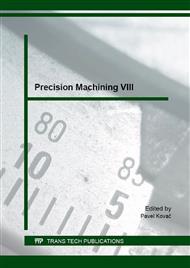p.161
p.168
p.174
p.180
p.186
p.194
p.200
p.204
p.212
The Grinding Fluid Influences on Surface Roughness Using Acoustic Emission
Abstract:
For optimization and control of the grinding process, it is necessary to monitor the process state. Fluid selection for grinding process is also considered as key factor for surface quality. This study focuses on the effects of different fluids in grinding process using Acoustic Emission technology. The analysis is carried out grouping the tests according to the main measured: Acoustic Emission (AE) signals, Normal and Tangential Forces on the workpiece surface, Grinding Temperature and Surface Roughness. The potential of real-time monitoring grinding process using Acoustic Emission technology is also tested. The results of this research show that selections of grinding fluids do have a significant influence on response factors such as surface roughness and AE signals. Further, prediction of surface roughness during the grinding process using AE signal monitoring is demonstrated in this work.
Info:
Periodical:
Pages:
186-193
Citation:
Online since:
February 2016
Authors:
Price:
Сopyright:
© 2016 Trans Tech Publications Ltd. All Rights Reserved
Share:
Citation:


